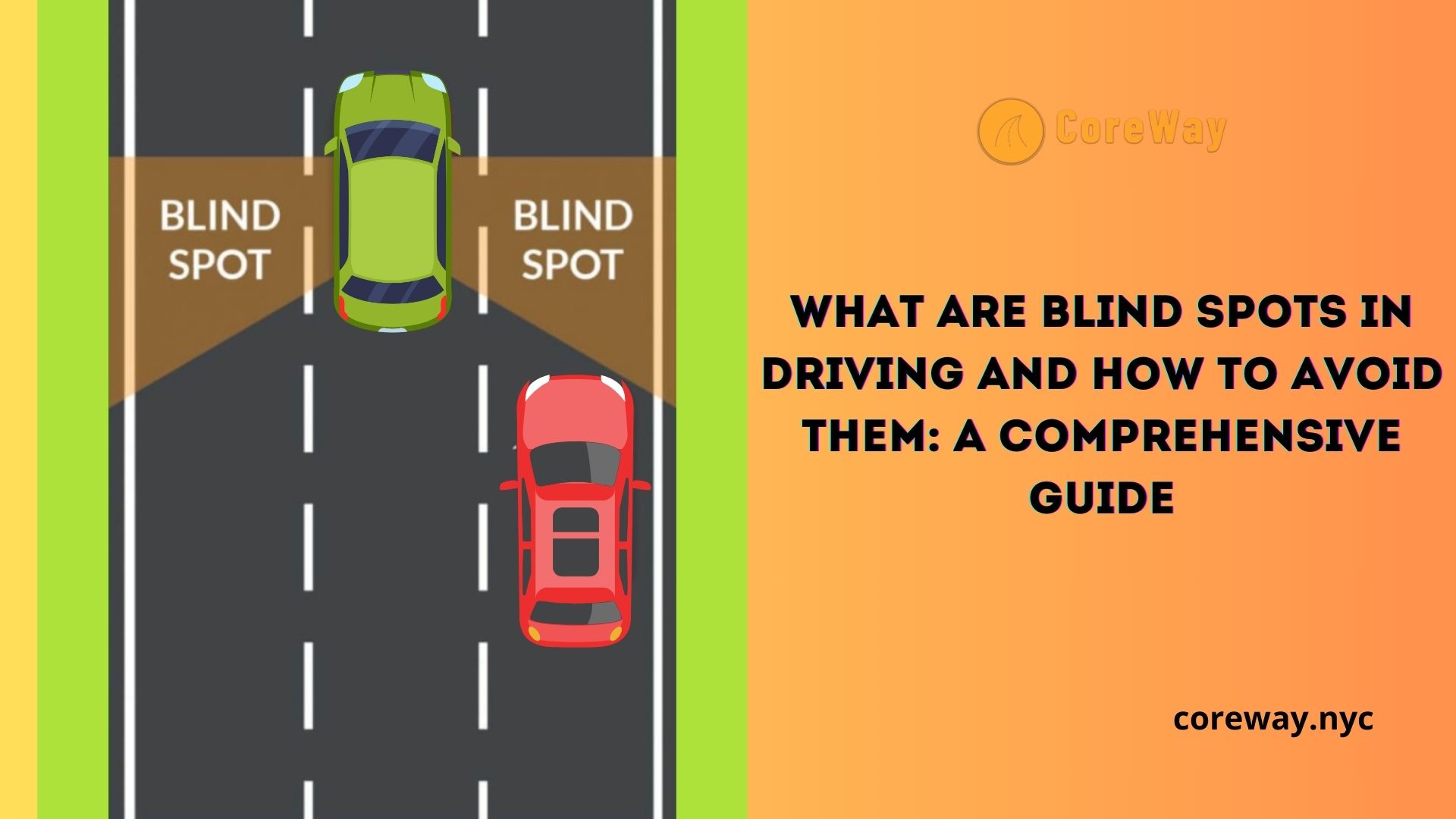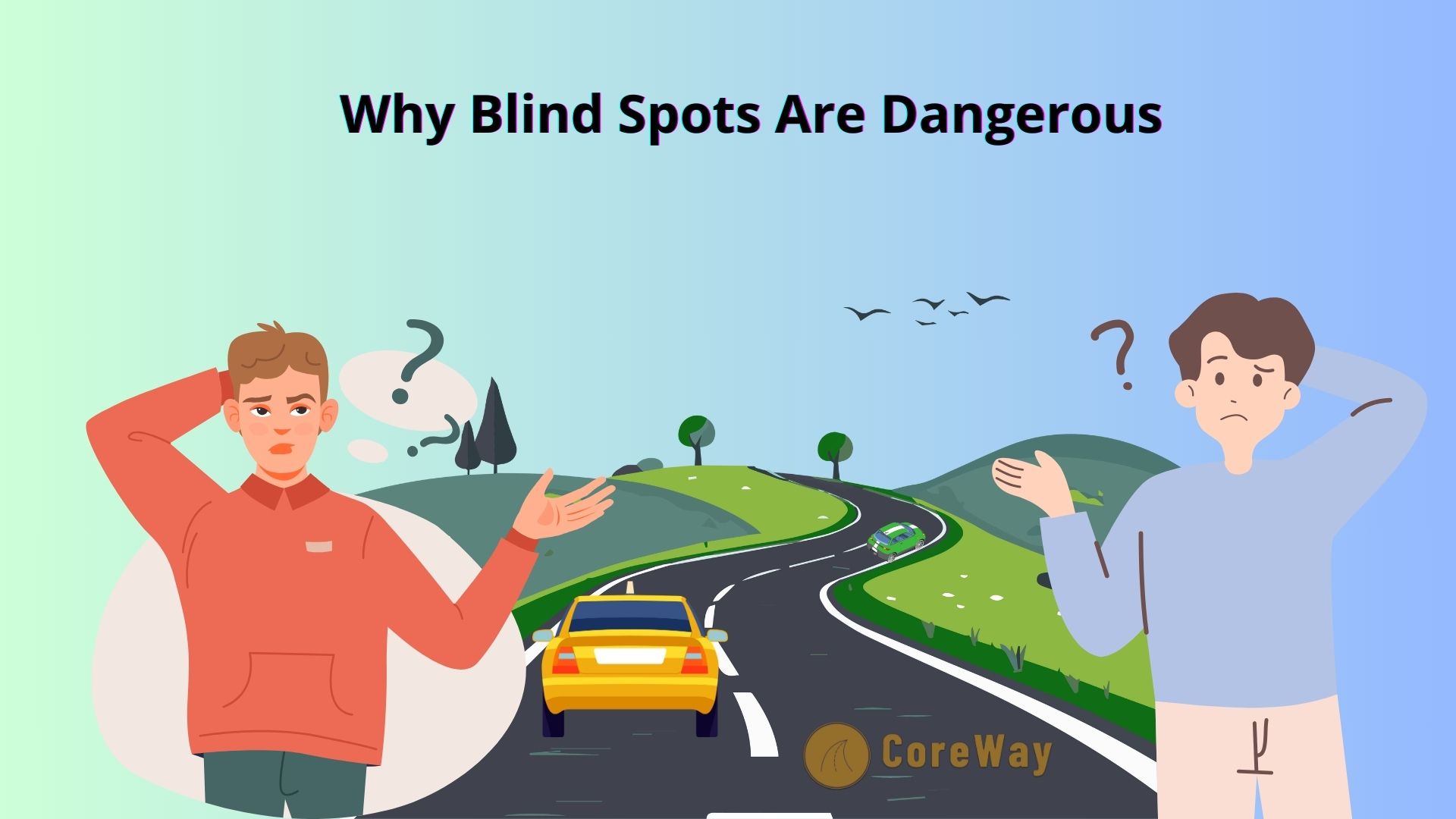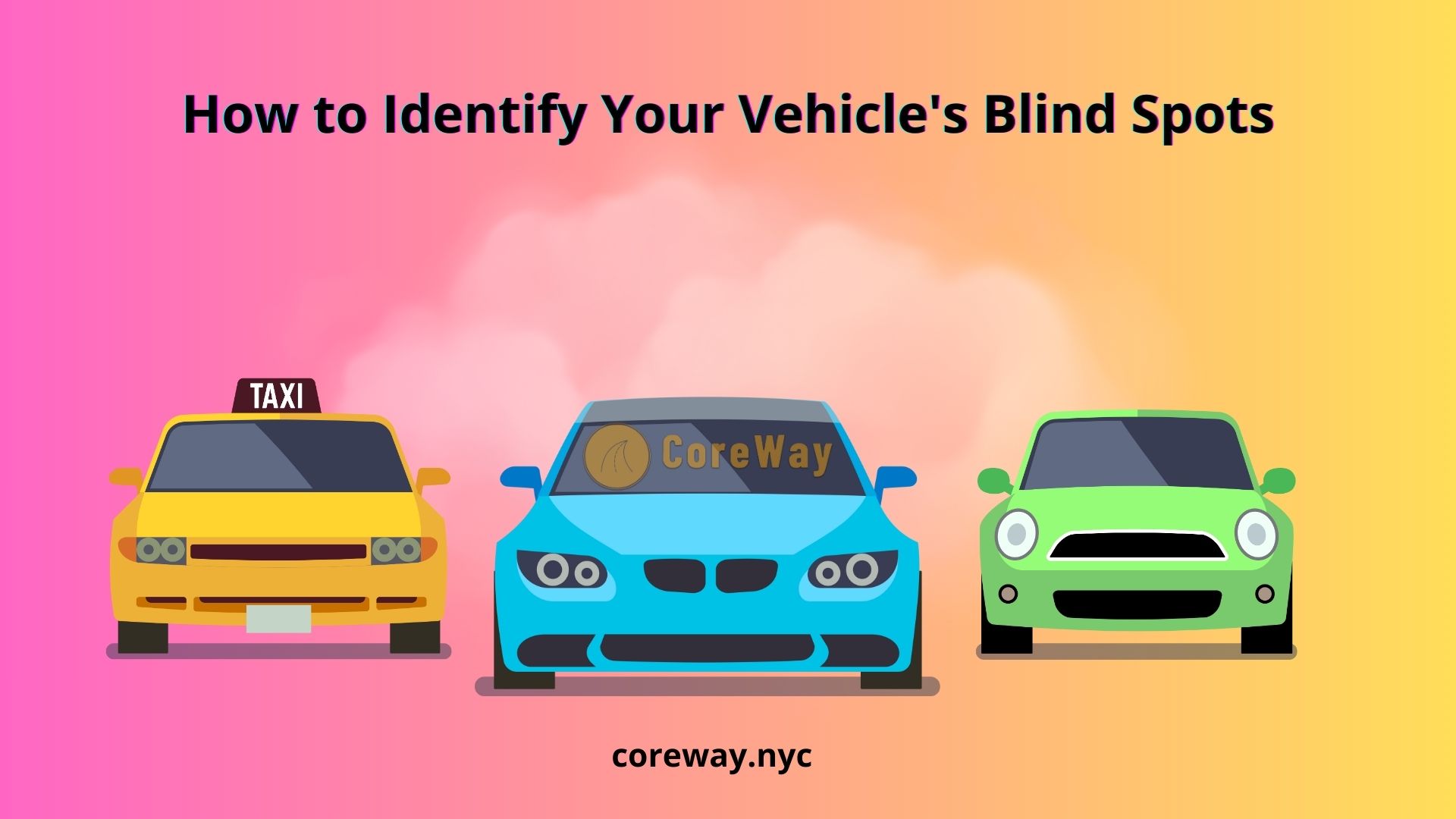What Are Blind Spots in Driving and How to Avoid Them: A Comprehensive Guide

Table of Contents
- What are blind spots in a car?
- What Causes Blind Spots?
- Common Blind Spot Locations
- Why Blind Spots Are Dangerous
- How to Identify Your Vehicle's Blind Spots
- Techniques to Avoid Blind Spot Accidents
- Technology and Tools to Reduce Blind Spots
- Specific Situations and Blind Spot Checks
- Being Mindful of Other Drivers' Blind Spots
- Additional Tips for Reducing Blind Spot Risks
- The Role of Blind Spot Awareness in Defensive Driving
- Blind Spots and Driver Education
- Mastering Blind Spot Management: Your Key to Safer Driving
Every driver, from novices to seasoned road warriors, faces a common challenge that can significantly impact road safety: blind spots. These elusive areas around your vehicle can hide potential hazards, making them a critical concern for safe driving. But what exactly are blind spots, and why are they so important to understand?
Key takeaways include:
- Proper mirror adjustment and regular visual checks are fundamental to blind spot management.
- The SMOG technique (Signal, Mirror, Over-the-shoulder, Go) is essential for safe lane changes and merging.
- Modern technologies like blind spot detection systems can aid but should not replace visual checks.
- Being aware of other vehicles' blind spots, especially those of larger vehicles, is as important as managing your own.
- Continuous education and practice in blind spot awareness are vital for drivers of all experience levels.
Call Us Today 6AM-10PM
Or fill out the form 24/7
Our team is here to guide you with promotions, instructor availability, and the best training package for you.
What are blind spots in a car?

Blind spots are areas around your vehicle that are outside the driver's field of vision when looking forward or using the rearview and side-view mirrors. These zones can easily conceal other vehicxs, motorcyclists, cyclists, or pedestrians, creating potential for accidents if not properly managed.
The Importance of Blind Spot Awareness
Understanding and effectively managing blind spots is crucial for several reasons:
- Accident Prevention: Properly checking blind spots can prevent collisions during lane changes, merging, and turning.
- Defensive Driving: Awareness of blind spots contributes to overall defensive driving skills.
- Driver's License Requirements: Blind spot checks are an essential part of every driver's license test.
- Vehicle Differences: Blind spots can vary significantly between different types of vehicles, making adaptability important.
It's widely acknowledged that blind spot-related accidents are a significant concern. Many modern vehicles now come equipped with blind spot detection systems to help mitigate these risks.
We'll delve deeper into the causes of blind spots, their locations, and most importantly, how to effectively manage and reduce the risks associated with them. Whether you're a new driver or looking to refresh your skills, this guide will provide valuable insights to enhance your safe use of the road.
What Causes Blind Spots?
Understanding the root causes of blind spots is crucial for effectively managing them. Let's explore the primary factors that contribute to these hidden zones around your vehicle.
Vehicle Structure
The design of your vehicle plays a significant role in creating blind spots. Key structural elements include:
- Vehicle Pillars: These are the vertical supports that hold up the roof of your car.
- A-pillars: Located on either side of the windshield
- B-pillars: Between the front and rear doors
- C-pillars: At the rear of the vehicle
- Roof Supports: These horizontal structures can obstruct views, especially in larger vehicles.
- Body Design: The overall shape of the vehicle can impact visibility, with some designs creating larger blind spots than others.
Mirror Limitations
While mirrors are essential for visibility, they have inherent limitations:
- Rearview Mirror: Provides a narrow view directly behind the vehicle
- Side-view Mirrors: Offer views of the adjacent lanes, but leave gaps
|
Mirror Type |
View Provided |
Blind Spot Created |
|
Rearview |
Directly behind |
Lower rear corners |
|
Side-view |
Adjacent lanes |
Rear quarters |
Driver's Field of Vision
The human eye has limitations that contribute to blind spots:
- Peripheral Vision: While useful, it doesn't provide detailed information about surroundings.
- Seating Position: How a driver sits can affect their overall visibility.
- Personal Factors: Issues like prescription glasses can sometimes create additional blind spots.
Vehicle Size and Type
Different vehicles have varying blind spot challenges:
- Sedans: Generally smaller blind spots, but still significant
- SUVs and Trucks: Larger vehicles often have more substantial blind spots
- Motorcycles: Have unique blind spot considerations due to their size and rider position
Common Blind Spot Locations
Understanding where blind spots typically occur is crucial for safe driving. While the exact locations can vary depending on your vehicle, there are several common areas to be aware of:
Rear Quarters
The most notorious blind spots are located in the rear quarters of your vehicle.
- Left Rear Quarter: This area is often hidden when checking the left side-view mirror.
- Right Rear Quarter: Similarly, this spot is obscured when using the right side-view mirror.
Immediately Behind the Vehicle
The area directly behind your vehicle, especially close to the rear bumper, can be a significant blind spot.
- This is particularly dangerous when backing out of a driveway or reversing in a parking lot.
- Rear-view cameras and rear parking sensors have become increasingly common to address this blind spot.
Front Corners (A-pillar Blind Spots)
The front corners of your vehicle, created by the A-pillars, can obscure pedestrians, cyclists, or even other vehicles at intersections.
- These blind spots are often overlooked but can be particularly dangerous when making turns or navigating intersections.
Areas Not Covered by Mirrors
Despite proper adjustment, there are still areas around your vehicle that mirrors can't capture:
- The space immediately to the sides of your vehicle
- Low areas near the ground, which can hide small objects or children
Table: Common Blind Spots and Associated Risks
|
Blind Spot Location |
Risk |
Mitigation |
|
Rear Quarters |
Lane change collisions |
Shoulder checks, blind spot monitoring |
|
Behind Vehicle |
Reversing accidents |
Backup cameras, careful scanning |
|
A-pillar (Front Corners) |
Missed pedestrians/cyclists at intersections |
Leaning forward to look around pillars |
|
Mirror Gaps |
Missing adjacent vehicles |
Proper mirror adjustment, head checks |
Vehicle-Specific Blind Spots
It's important to note that blind spot locations can vary significantly based on vehicle type:
- Sedans: Generally have smaller blind spots but still significant in rear quarters.
- SUVs and Trucks: Larger vehicles often have more substantial blind spots, especially in the rear and front corners.
- Motorcycles: Have unique blind spot considerations due to their size and rider position.
While getting licensed to drive in New York, immigrants will need to demonstrate their ability to effectively check and manage blind spots.
Why Blind Spots Are Dangerous
Understanding the dangers associated with blind spots is crucial for appreciating the importance of proper blind spot management. Let's explore the key reasons why blind spots pose significant risks on the road.
Risk of Collisions During Lane Changes and Merging
One of the most common scenarios where blind spots become dangerous is during lane changes and merging maneuvers.
- Sudden Lane Changes: A vehicle hidden in your blind spot can lead to a collision if you change lanes without proper checks.
- Highway Merging: When merging onto highways, failing to check blind spots can result in cutting off other vehicles or forcing them to brake suddenly.
Potential for Missing Vulnerable Road Users
Blind spots can obscure more than just other vehicles:
- Cyclists: Often travel in areas prone to being in vehicle blind spots.
- Motorcyclists: Their smaller size makes them even more likely to be hidden in blind spots.
- Pedestrians: Particularly at risk in urban environments and parking lots.
Increased Danger in Poor Conditions
The risks associated with blind spots are amplified in certain conditions:
- Driving in Rain: Reduced visibility makes blind spot checks even more crucial.
- Night Driving: Darkness can make it harder to spot vehicles in your blind spots.
- Heavy Traffic: More vehicles around you increase the likelihood of something being hidden in a blind spot.
Table: Blind Spot Dangers in Different Scenarios
|
Scenario |
Primary Risk |
Secondary Risks |
|
Lane Changes |
Side-swipe collisions |
Forced off-road incidents, multi-car pile-ups |
|
Merging |
Rear-end collisions |
Traffic flow disruption, road rage incidents |
|
Urban Driving |
Pedestrian/cyclist accidents |
Property damage, legal consequences |
|
Highway Driving |
High-speed collisions |
Severe injuries, fatalities |
Compounding Factors
Several factors can compound the dangers of blind spots:
- Driver Inattention: Distracted driving makes blind spot checks even more likely to be missed.
- Overreliance on Technology: While helpful, blind spot detection systems shouldn't replace visual checks.
- Lack of Defensive Driving Skills: Not anticipating other drivers' actions can lead to blind spot-related accidents.
Long-Term Consequences
The dangers of blind spots extend beyond immediate accidents:
- Personal Injury: Collisions caused by blind spot oversights can lead to serious injuries.
- Legal and Financial Implications: Accidents can result in lawsuits and increased insurance premiums.
- Psychological Impact: Even minor accidents can affect a driver's confidence and comfort on the road.
Call Us Today 6AM-10PM
Or fill out the form 24/7
Our team is here to guide you with promotions, instructor availability, and the best training package for you.
How to Identify Your Vehicle's Blind Spots

Understanding the location and extent of your vehicle's blind spots is crucial for safe driving. Here are effective methods to identify these areas:
Stationary Vehicle Check
This method allows you to visualize your blind spots while the vehicle is parked:
- Sit in the Driver's Seat:
- Adjust your seat to your normal driving position.
- Adjust all mirrors as you would for driving.
- Place Objects Around Your Vehicle:
- Use traffic cones, stuffed animals, or other visible objects.
- Position them at various points around your car, especially in suspected blind spot areas.
- Observe from the Driver's Seat:
- Without moving your head, note which objects you can and cannot see.
- Areas where objects are not visible are your blind spots.
Moving Vehicle Assessment
This method involves a helper and allows you to understand your blind spots in motion:
- Find an Empty Parking Lot:
- Ensure there's enough space to drive slowly and safely.
- Position a Helper:
- Have someone slowly walk around your vehicle as you remain in the driver's seat.
- Ask them to stop when they're no longer visible in your mirrors or through windows.
- Mark the Spots:
- Note where your helper disappears from view.
- These points represent the edges of your blind spots.
Table: Common Blind Spot Locations by Vehicle Type
|
Vehicle Type |
Primary Blind Spots |
Secondary Blind Spots |
|
Sedan |
Rear quarters |
A-pillar areas |
|
SUV/Truck |
Large rear quarters, behind vehicle |
Front corners, A-pillar areas |
|
Hatchback |
Rear window area |
Rear quarters |
|
Van |
Extended rear quarters |
Front corners, sides |
Using Technology
Modern vehicles often come equipped with tools to help identify blind spots:
- Blind Spot Detection Systems: These can alert you to vehicles in your blind spots.
- 360-Degree Cameras: Provide a bird's-eye view of your vehicle, revealing blind spots.
- Wide-Angle Side-View Mirrors: Can expand your field of vision and reduce blind spots.
Professional Assessment
If you're still unsure about your vehicle's blind spots:
- Consider visiting a driving school or professional instructor.
- They can provide a thorough assessment of your specific vehicle's blind spots.
- This is especially useful for new drivers or those adapting to a new vehicle type.
Adjusting for Different Conditions
Remember that blind spots can change based on various factors:
- Weather Conditions: Rain, snow, or fog can affect visibility and alter blind spots.
- Time of Day: Nighttime driving may create different blind spot challenges.
- Cargo: Loading your vehicle, especially with large items, can create new blind spots.
Techniques to Avoid Blind Spot Accidents
Knowing where your blind spots are is only half the battle. The key to safe driving is effectively managing these areas. Here are essential techniques to help you avoid blind spot-related accidents:
Proper Mirror Adjustment
Correctly adjusted mirrors can significantly reduce blind spots:
- Rearview Mirror Positioning:
- Adjust so you can see the entire rear window.
- Center the view without tilting.
- Side Mirror Setup:
This setup minimizes overlap between mirrors, maximizing your field of view.
The SMOG Technique
SMOG is a crucial technique for safe lane changes and merging:
- S: Signal your intention
- M: Check your Mirrors
- O: Look Over your shoulder (perform a head check)
- G: Go if it's clear
Head Checks and Shoulder Checks
Physical checks are vital for areas mirrors can't cover:
- Head Check: Quick turn of the head to view blind spots.
- Shoulder Check: More thorough look, especially before lane changes.
Important: Perform these checks quickly to avoid taking your eyes off the road for too long.
Using Peripheral Vision Effectively
While not a substitute for direct checks, peripheral vision can help:
- Be aware of movement in the corners of your eyes.
- Use this to prompt more thorough checks when needed.
Table: Blind Spot Check Techniques for Different Maneuvers
|
Maneuver |
Primary Technique |
Secondary Technique |
|
Lane Change |
SMOG |
Quick mirror scan before moving |
|
Merging |
SMOG + extended mirror check |
Accelerate to match traffic speed |
|
Turning |
Mirror + shoulder check |
Check A-pillar blind spot |
|
Reversing |
360° scan + use of all mirrors |
Use backup camera if available |
Leveraging Technology
Modern vehicles often come with helpful features:
- Blind Spot Detection Systems: Use these as a supplement, not a replacement for visual checks.
- Rear-View Cameras: Especially useful for backing up and parallel parking.
- Lane Departure Warning Systems: Can alert you if you're drifting without signaling.
Defensive Driving Practices
Incorporate these habits to further reduce blind spot risks:
- Maintain a safe following distance to improve overall visibility.
- Be predictable in your movements to help other drivers anticipate your actions.
- Use turn signals consistently and well in advance of maneuvers.
- Avoid lingering in other vehicles' blind spots, especially for trucks and large vehicles.
Regular Practice and Awareness
- Make blind spot checks a consistent part of your driving routine.
- Stay updated on your vehicle's blind spots, as they can change with modifications or cargo.
- Consider periodic refresher courses or defensive driving classes to maintain and improve your skills.
Technology and Tools to Reduce Blind Spots
As vehicle technology advances, numerous innovations have emerged to help drivers manage blind spots more effectively. While these tools should never replace visual checks and good driving habits, they can provide valuable additional support.
Wide-Angle Side-View Mirrors
These mirrors offer an expanded field of view compared to standard side mirrors.
- Benefits:
- Reduce blind spot size
- Provide a wider view of adjacent lanes
- Considerations:
- Objects may appear smaller than they actually are
- Requires adjustment period for accurate distance perception
Blind Spot Detection Systems
Modern vehicles often come equipped with sensors that alert drivers to objects in their blind spots.
- How they work:
- Use radar or cameras to detect vehicles in adjacent lanes
- Typically provide visual alerts on side mirrors or A-pillars
- Types of alerts:
- Visual (lights)
- Audible (beeps or chimes)
- Haptic (steering wheel vibration)
Note: While helpful, these systems shouldn't be relied upon exclusively. Always perform visual checks.
Rear-View Cameras
Mandated on all new vehicles in many countries, rear-view cameras significantly reduce rear blind spots.
- Primary use: Assisting with reversing and parking
- Advanced features:
- Dynamic guidelines
- Wide-angle views
- Night vision capabilities
Lane Departure Warning Systems
While primarily designed to prevent unintentional lane drifting, these systems can indirectly help with blind spot awareness.
- Function: Alert driver when vehicle begins to move out of its lane without a turn signal activated
- Benefit: Can prevent lane changes when a vehicle is in the blind spot
Table: Comparison of Blind Spot Technologies
|
Technology |
Pros |
Cons |
Best For |
|
Wide-Angle Mirrors |
No electronics, always functional |
Distortion, adjustment period |
All drivers |
|
Blind Spot Detection |
Active monitoring, clear alerts |
Can malfunction, may create overreliance |
Highway driving |
|
Rear-View Camera |
Eliminates rear blind spot |
Limited to rear view, can get dirty |
Parking, reversing |
|
Lane Departure Warning |
Prevents unintended lane changes |
May have false alarms, can be annoying |
Long trips, highway driving |
360-Degree Camera Systems
Some high-end vehicles offer a bird's-eye view of the car and its surroundings.
- How it works: Combines feeds from multiple cameras around the vehicle
- Benefits:
- Eliminates most blind spots during low-speed maneuvers
- Extremely useful for parking in tight spaces
Heads-Up Displays (HUDs)
While not specifically designed for blind spot detection, HUDs can integrate blind spot information into the driver's line of sight.
- Advantage: Allows drivers to receive blind spot alerts without taking eyes off the road
Aftermarket Solutions
For vehicles without built-in blind spot technology, several aftermarket options are available:
- Stick-on blind spot mirrors
- Blind spot sensor kits
- Dash cams with blind spot monitoring features
Important Considerations
While these technologies can greatly assist in managing blind spots, it's crucial to remember:
- No technology is infallible – always perform visual checks.
- Familiarize yourself with how your vehicle's systems work and their limitations.
- Regular maintenance is essential to ensure these systems function correctly.
- Technology should complement, not replace, good driving habits and techniques.
Specific Situations and Blind Spot Checks
Different driving scenarios require specific approaches to blind spot management. Let's explore some common situations and the best practices for each.
Changing Lanes
Lane changes are one of the most critical moments for blind spot awareness.
- Steps for safe lane changes:
- Activate your turn signal
- Check mirrors
- Perform a quick shoulder check
- Change lanes smoothly if clear
Merging onto Highways
Merging requires extra vigilance due to speed differentials and limited space.
- Best practices:
- Adjust speed to match highway traffic
- Use merge lanes fully to gain visibility
- Check mirrors and blind spots continuously
- Look for gaps in traffic
Turning at Intersections
Intersections present unique blind spot challenges, especially with A-pillar obstructions.
- Tips for safe turns:
- Approach slowly to allow time for thorough checks
- Be aware of pedestrians and cyclists in crosswalks
- Check your A-pillar blind spots before proceeding
Backing Out of Driveways or Parking Spots
Reverse maneuvers often involve significant blind spots.
- Steps for safe reversing:
- Walk around your vehicle before entering
- Use all mirrors and backup cameras if available
- Turn and look over both shoulders
- Back up slowly, continuing to check all angles
Parallel Parking
Parallel parking requires awareness of blind spots on all sides of the vehicle.
- Techniques:
- Use mirrors and cameras for guidance
- Perform frequent head checks
- Be especially aware of pedestrians and cyclists
Table: Blind Spot Checks for Different Maneuvers
|
Maneuver |
Primary Checks |
Secondary Checks |
Technology Aids |
|
Lane Change |
Mirrors, shoulder check |
Front quarter check |
Blind spot monitoring |
|
Highway Merging |
Mirrors, extended shoulder check |
Speed matching |
Lane departure warning |
|
Intersection Turns |
A-pillar checks, mirrors |
Pedestrian scan |
360-degree cameras |
|
Reversing |
Rear and side mirrors |
Full 360° visual scan |
Backup camera, sensors |
|
Parallel Parking |
Side mirrors, rear check |
Front and rear corner checks |
Parking sensors, cameras |
Being Mindful of Other Drivers' Blind Spots
Understanding and respecting other vehicles' blind spots is as important as managing your own.
Avoiding Lingering in Blind Spots
- General rule: If you can't see the driver's face in their side mirror, you're likely in their blind spot.
- Action: Either speed up or slow down to move out of the blind spot quickly.
Special Considerations for Trucks and Large Vehicles
Trucks and buses have significantly larger blind spots than passenger vehicles.
- Key blind spots for large vehicles:
- Directly in front
- Directly behind
- Along both sides, especially on the right
Remember that other vehicles have blind spots too. Avoid lingering in these areas, especially for large vehicles like trucks and buses.
The "No-Zone"
The "No-Zone" refers to areas around trucks where crashes are more likely to occur.
- Best practices:
- Pass trucks quickly and safely
- Never cut in front of a truck abruptly
- Give trucks extra space when they're turning
Motorcycle Awareness
Motorcycles can easily slip into blind spots due to their small size.
- Tips for sharing the road with motorcycles:
- Double-check blind spots before changing lanes
- Provide extra following distance
- Be extra cautious at intersections
Anticipating Other Drivers' Actions
- Defensive driving involves predicting and accommodating other drivers' movements.
- Watch for indicators of potential lane changes or merges.
Communicating with Other Drivers
Clear communication can help mitigate blind spot risks.
- Effective communication methods:
- Always use turn signals
- Use headlights to increase visibility
- Use horn sparingly to alert others of your presence
Additional Tips for Reducing Blind Spot Risks
Beyond the fundamental techniques, there are several additional strategies to further minimize blind spot dangers.
Keeping Windows and Mirrors Clean
Visibility is crucial for managing blind spots effectively.
- Regular cleaning: Ensure all windows and mirrors are clean and free from obstructions.
- Special attention: Focus on areas prone to dirt accumulation, like side mirrors.
Ensure all your windows and mirrors are clean and unobstructed. Remove any hanging objects that might block your view.
Removing Obstructions from Windows
- Common culprits:
- Stickers
- Hanging air fresheners
- GPS devices mounted in suboptimal positions
Tip: Position necessary items (like GPS devices) where they don't obstruct critical viewing areas.
Adjusting Seat Position for Optimal Visibility
Proper seating position not only enhances comfort but also maximizes visibility.
- Steps for optimal seating:
- Adjust seat height for clear view over the steering wheel
- Ensure you can reach pedals comfortably
- Position seat for easy access to all controls
Being Aware of Prescription Glasses Affecting Peripheral Vision
Some eyewear can create additional blind spots.
- Considerations:
- Be aware of frame thickness and its impact on peripheral vision
- Consult with an optometrist about driving-optimized lenses
Table: Quick Checklist for Reducing Blind Spot Risks
|
Area |
Action |
Frequency |
|
Windows |
Clean thoroughly |
Weekly or as needed |
|
Mirrors |
Adjust and clean |
Daily |
|
Interior |
Remove obstructions |
Before each trip |
|
Seating |
Optimize position |
Any time driver changes |
|
Eyewear |
Check for vision impacts |
Annually or with prescription changes |
The Role of Blind Spot Awareness in Defensive Driving
Incorporating blind spot awareness into your overall defensive driving strategy is crucial for road safety.
Anticipating Other Drivers' Actions
- Observation: Constantly scan the road for potential hazards.
- Prediction: Try to foresee possible movements of surrounding vehicles.
Maintaining Safe Following Distances
Adequate space provides more time to react to blind spot-related issues.
- 3-second rule: Maintain at least a 3-second gap between you and the vehicle ahead.
- Adjust for conditions: Increase this distance in poor weather or at higher speeds.
Using Turn Signals Consistently
Clear communication of your intentions helps others anticipate your movements.
- Signal early: Activate turn signals well before changing lanes or turning.
- Be predictable: Use signals even when you don't see other vehicles nearby.
Blind Spots and Driver Education
Proper education on blind spot management is essential for all drivers, from novices to experienced motorists.
Importance in Driving Tests
Blind spot checks are a critical component of driver's license examinations.
- Test elements:
- Mirror checks
- Shoulder checks
- Proper lane change procedures
Ongoing Awareness and Practice for Experienced Drivers
Even seasoned drivers benefit from refreshing their blind spot management skills.
- Continuous improvement strategies:
- Attend defensive driving courses
- Stay updated on new vehicle technologies
- Regularly self-assess driving habits
Adapting to Different Vehicles
Each vehicle has unique blind spot characteristics.
- Rental cars: Take time to familiarize yourself with blind spots before driving.
- New vehicle purchases: Spend extra time learning the blind spot profile of your new car.
Teaching New Drivers
For parents or instructors teaching new drivers:
- Emphasize the importance of blind spot checks from the beginning.
- Provide plenty of supervised practice in various driving scenarios.
- Teach the proper use of blind spot assistance technologies without over-reliance.
Table: Key Blind Spot Topics in Driver Education
|
Topic |
Importance |
Teaching Method |
|
Mirror Adjustment |
High |
Practical demonstration |
|
Shoulder Checks |
Critical |
In-car practice |
|
Technology Use |
Moderate |
Hands-on with vehicle features |
|
Spatial Awareness |
High |
Parking lot exercises |
|
Other Vehicle Blind Spots |
Important |
Visual aids and on-road observation |
While it takes time to learn driving skills, understanding and managing blind spots should be a priority from the beginning.
Discover how can I rent a car for road test purposes and what special requirements apply.
Mastering Blind Spot Management: Your Key to Safer Driving
Understanding and effectively managing blind spots is a crucial aspect of safe driving that can significantly reduce the risk of accidents on the road. Throughout this comprehensive guide, we've explored the causes of blind spots, their locations, and the various techniques and technologies available to mitigate their risks.
Remember, effective blind spot management is not just about personal safety; it's about contributing to the overall safety of our roads. By implementing these strategies and maintaining a vigilant approach to blind spots, you can become a more confident and responsible driver.
Stay alert, practice these techniques regularly, and always prioritize safety on the road. Your increased awareness and skill in managing blind spots will not only protect you but also those sharing the road with you.
Call Us Today 6AM-10PM
Or fill out the form 24/7
Our team is here to guide you with promotions, instructor availability, and the best training package for you.
Frequently Asked Questions
-
What exactly are blind spots in driving?
Blind spots are areas around your vehicle that cannot be seen directly by the driver or through the rearview and side mirrors. These areas are typically located to the rear sides of the vehicle and can hide other vehicles, cyclists, or pedestrians from view.
-
Can blind spots be eliminated completely?
While blind spots can't be eliminated entirely, they can be significantly reduced through proper mirror adjustment, regular head checks, and the use of blind spot detection technologies.
-
How often should I check my blind spots?
You should check your blind spots every time you change lanes, merge into traffic, or make turns. It's also a good practice to be aware of your blind spots continuously while driving.
-
Are blind spot detection systems reliable?
Blind spot detection systems can be very helpful, but they shouldn't be relied upon exclusively. These systems can malfunction or miss smaller objects. Always combine their use with visual checks.
-
How do blind spots differ in various vehicle types?
Blind spots can vary significantly between different vehicle types. Generally, larger vehicles like SUVs and trucks have bigger blind spots compared to sedans. Motorcycles have unique blind spot considerations due to their size.
-
What is the SMOG technique?
SMOG stands for Signal, Mirror, Over-the-shoulder, Go. It's a technique used for safe lane changes and merging, ensuring you check your blind spots before making a move.
-
How can I adjust my mirrors to minimize blind spots?
Adjust your side mirrors outward until you can barely see the side of your own car. This setup reduces overlap with your rearview mirror and maximizes your field of view.
-
What should I do if I can't see well due to blind spots?
If you're having difficulty with blind spots, consider adding blind spot mirrors, adjusting your seating position, or using blind spot detection technology if available. If problems persist, consult with a driving instructor or optometrist.
-
What should I do if I can't see well due to blind spots?
If you're having difficulty with blind spots, consider adding blind spot mirrors, adjusting your seating position, or using blind spot detection technology if available. If problems persist, consult with a driving instructor or optometrist.
-
What should I do if I can't see well due to blind spots?
If you're having difficulty with blind spots, consider adding blind spot mirrors, adjusting your seating position, or using blind spot detection technology if available. If problems persist, consult with a driving instructor or optometrist.
 English
English Spanish
Spanish 

